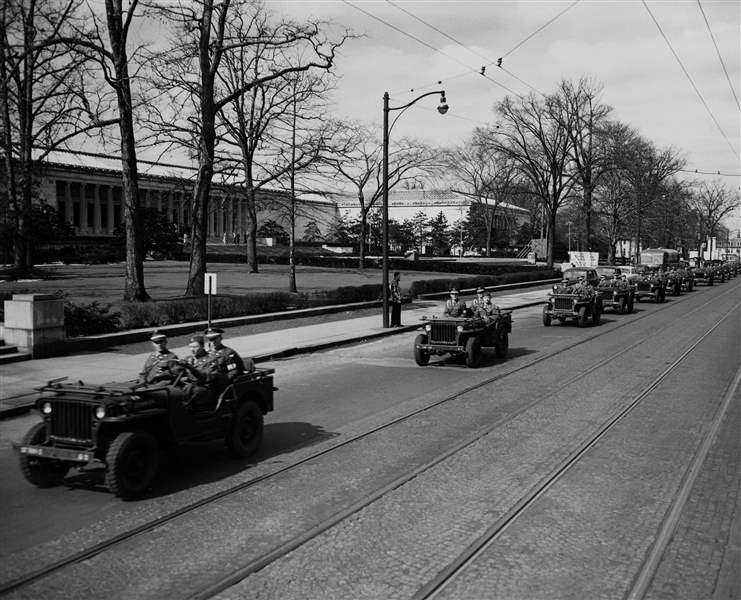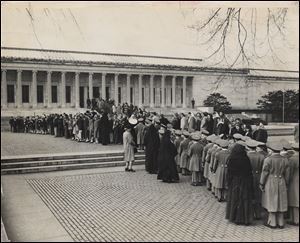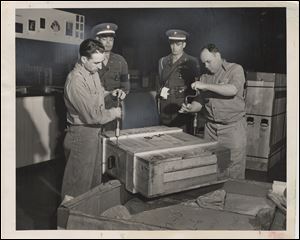
Toledoans had look at art saved by real-life Monuments Men
Museum last on tour of works hidden in mine
2/17/2014
A convoy, escorted by military police, delivers the paintings to the Toledo Museum of Art in 1949 on the last stop of a U.S. tour. The museum’s assistant director was among the 345 Monuments Men.
Toledo Museum of Art

A convoy, escorted by military police, delivers the paintings to the Toledo Museum of Art in 1949 on the last stop of a U.S. tour. The museum’s assistant director was among the 345 Monuments Men.
Sixty-five years ago, residents lined up at the Toledo Museum of Art to see more than 90 European paintings Nazis had buried deep in a German salt mine.
Toledo was the smallest city and final stop on an American tour showcasing pictures plucked by the U.S. Army from the Merkers mine, where Germans hid treasures from Berlin museums during World War II.
This dramatic period in art history — when military forces and art experts saved masterpieces stashed, stolen, and threatened to be destroyed by Adolf Hitler — is depicted in the recently released movie The Monuments Men.
Toledo has ties to this unique time, connections made before Hollywood’s historical interpretation trained a brighter spotlight on the era.
In 1949, more than 100,000 people streamed into the Toledo museum during the 10-day exhibit of works by masters such as Rembrandt, Rubens, and Titian. The paintings, valued then at $50 million, had been recovered from the mine by the 3rd U.S. Army in 1945.
PHOTO GALLERY: Toledo's World War II art connection
“Can you imagine, 10,000 people a day?” said Toledo museum archivist Julie McMaster, who attributed the exhibit’s popularity to media attention, relief and celebration for the Allied victory, and “great curiosity as to what these paintings were.”
Unlike other art-cache discoveries, the paintings in the Merkers mine were not prizes looted by Nazis. They hailed from Berlin museums and had been tucked underground as the city faced attack. Once uncovered, many works came to the United States until they could be returned to Germany.
During their U.S. stay, some of the paintings toured major cities including New York City, Philadelphia, Chicago, Los Angeles, Detroit, Cleveland, and Pittsburgh. Toledo was the final stop.
The local museum’s then-assistant director Otto Wittmann, who died in 2001, joined the Army Air Force in 1941 and toward the end of the war investigated art stolen by Nazis to help return pieces to the appropriate country.

People stand in line at the Toledo Museum of Art to view more than 90 European paintings. More than 100,000 people saw the 10-day exhibit In 1949.
He’s listed as one of the Monuments Men, the term used for about 345 men and women of the Monuments, Fine Arts, and Archives section of the Allied armies, by the Monuments Men Foundation for the Preservation of Art. The foundation was started by author Robert Edsel, who wrote a book that was adapted into the movie.
Mr. Wittmann’s connections helped secure the exhibit for Toledo, Ms. McMaster said.
The show was a smash and a spectacle.
Photographs depict a military police convoy parading through town to deliver the artwork, transported in padded and heated railcars typically used for thoroughbred horses and then brought by truck to the museum.
Of the dozen or so cities that exhibited the art, Toledo posted the highest attendance in proportion to population and brought in $14,379 in donations and admissions to benefit children in Germany.
One visitor who checked out the exhibit had glimpsed the artwork before. In 1945, Jack Ammons of Findlay was a member of the First Battalion of the 357th Regiment, 90th Infantry Division, 3rd Army. His unit was pushing through Europe and engaging in regular combat.
“All I know was that Merkers was just another town. They were [capturing] towns, occupying towns one after another,” said his son Ron Ammons, the head softball coach at the University of Findlay.
His father, who died in 1979, was among the soldiers who went into the salt mine to move treasures found below. Jack Ammons spoke openly about his war experiences, but this particular intersection with art history didn’t come up much, his son said.
The elder Ammons, in a 1949 interview with Findlay’s Republican-Courier newspaper, recounted how he and others saw the labeled crates of art.
He spent a week at the mine, where he recalled the long, underground tunnels and loading the treasures onto Jeeps that were lifted to the mine’s ground level by elevator. Several years later, as a junior at what was then Findlay College, he saw the art again. This time it was showcased on the walls of the Toledo museum.

Crates are opened up under Army supervision. The paintings came from other cities in padded and heated railcars and then by truck.
“It just goes to show you that history, it just happens. People are in a certain place at a certain time … ; this was one of those moments,” Ron Ammons said. “I’m sure Dad had no idea as a teenager what these were worth.”
Once hoisted to the surface, hundreds of pictures were wrapped in German army sheepskin coats and moved by trucks, according to research by Greg Bradsher, senior archivist with the U.S. National Archives and Records Administration.
Despite some objections, the most important paintings eventually went to the United States for safekeeping.
“The philosophy was until the German museums were able to be rebuilt, and it could go back to them,” Mr. Bradsher said in a telephone interview.
Officials agreed to an exhibit at the National Gallery of Art in Washington and then allowed some paintings to tour the country. The Toledo museum lobbied strenuously to be included, according to its documents. Venues in bigger cities shaved one day off their own exhibits to give Toledo time to display the art before their return to Germany.
Some paintings were too fragile to travel with the exhibit, and others were sent back sooner to Germany as a good-faith gesture by the Army. But 93 paintings filled seven west-wing galleries in the Toledo Museum of Art.
In an address made at the exhibit’s opening, the then-director of the St. Louis Art Museum extolled why art — this art — was important.
“For many the exhibition will be a discovery, a revelation; the beginning of a lifelong pleasure in the contemplation of works art,” said Perry Rathbone, according to a speech transcript. “It will make the people of Toledo more appreciative and prouder of the wonderful works of art they have in their own museum. And I am confident the exhibition has already greatly elevated the place that art occupies in the public mind as no other event in the art history of this country has done.”
Contact Vanessa McCray at: vmccray@theblade.com, 419-724-6065, or on Twitter @vanmccray.